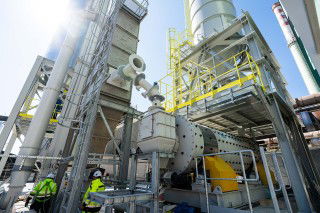This week, Cemtech reviewed recent advances in clinker reduction technologies in its latest webinar. A top-quality line-up of leading experts saw Professor Karen Scrivener of EPFL, Joel Maia, CEO of FCT Combustion and Leo Fit, product manager of activated clays at thyssenkrupp Industrial Solutions (TKIS) outline how they see the future development of clinker reduction, from the introduction of LC3 cements to the different equipment required to calcinate clays and how to source the best clays for production.
Although Karen Scrivener began the presentations by explaining that Portland cement will still dominate cement production volumes for the foreseeable future, she described LC3 as "a breakthrough technology". While cementitious materials are not new for cement production, Professor Scrivener argued that the limited availability of slag and fly ash are directing cement producers towards the use of activated clays for lower clinker cements. "Calcined clay is the most available material in the quantities needed," she said.
Kaolin clays are paramount for calcined clay production
LC3 includes the use of suitable clays such as kaolin, illite and metakaolin that can be activated to become a reactive binder when blended with gypsum, limestone and clinker. Kaolinite will be the most suitable clay to use because each layer is built up of a silica and alumina content that is disrupted when heated and becomes available to react with limestone. The ideal kaolinite content is 40-60 per cent in calcined clay cements, said Professor Scrivener.
Such clays are widely available in China, southeast Asia, Africa and the Americas. Some of these regions are where population growth is expected to grow fastest during the 21st century. Tests have already shown that while calcined clay cements have a lower early 1-2 day strength than OPC, they overtake fly ash and slag cement strengths by seven days and have higher strength than Portland cements after 28 days.
The advantages of using calcined clays for cement production are many, including activation at lower temperatures than clinker producition, typically between 600-850˚C, the potential to use existing rotary kilns and easy colour control. Among the disadvantages are high energy consumption to dry material when using flash calcination, sourcing suitable clays near to existing cement plant locations, and ensuring good workability of LC3 cements and concretes.
Karen Scrivener referred to trials that have seen CO2 reduction of LC3 cements reach 475kg/t compared to 520kg/t for PPC and 695kg/t with OPC manufacture. She also highlighted that LC3 could take the clinker factor down below the 2009 roadmap forecast of 73 per cent to 60 per cent and even 45 per cent. “A 60 per cent clinker factor would give CO2 savings of 400Mt of CO2 per annum or 10 times the annual emissions of a country like Switzerland,” she said.
Europe, America and India are all looking to bring in new regulations for calcined clays. The European standards, which are used in Africa and Asia as well, will see the CEM IIC standard introduced in the next few months. The standard will allow a 50 per cent clinker factor in calcined clay cements, a major advance on the 65 per cent currently set by the EN197 CEM II standard.
Karen Scrivener was joined by Professor Fernando Maritirena of UCLV in Cuba and Alberto Putin of IPIAC in Portugal for questions. IPIAC has many years of experience in using clays for brick production and has built a new plant in Côte d'Ivoire, while UCLV operated one of the first pilot plants for LC3 to make concrete blocks and houses.
Rotary kiln of flash calcination?
Joel Maia, FCT Combustion, furthered the discussion by describing the two options that FCT Combustion offers as equipment solutions for the manufacture of calcined clays. He compared the choice of the flash calciner and the rotary kiln. FCT manufactures the FCT FlashCalx™ flash calciner and the RotaCalx™ rotary kiln, which gives it valuable experience of both methods of production.
Mr Maia claimed that the flash calciner offers the best temperature control, which is important for ensuring the reactivity of the calcined clay. This solution removes inert material before calcination in pregrinding, which also has the benefit of drying the raw material. Moreover, it enables the greater use of alternative fuels and reduces fuel consumption, although it has higher capex costs.
The rotary kiln requires no pregrinding before being fed to the kiln and it deals better with higher moisture contents. Its disadvantages include more limited alternative fuel usage, lower temperatures from secondary air for drying raw materials and grinding after calcination.
From raw materials to full-scale production
The final presentation by Leo Fit of TKIS highlighted the polysius® activated clay system. The German company is already building its first full-scale activated clay cement plant in west Africa and Mr Fit outlined the process that TKIS takes customers through when configuring a plant. This included a GEO service for selecting the best available clay to use in manufacture, assessment of costs, low moisture content and emissions, further lab tests for cement quality forecasting, and a third pilot-scale plant for flash activation before the technical solution and realisation of a project.
TKIS uses a 50kg/h pilot plant in Beckum for testing clay samples for calcination and it has a larger 500kg/h outside unit for larger volumes.
TKIS see the advantages of a flash calcination system as reduced retention times, better temperature steering, higher temperatures without destroying kaolinite, moisture levels below 2˚C and no dust. The system uses a hammer mill to dry and reduce material to 2mm before being fed to the activator unit. Calcined clay, limestone, gypsum and clinker can then be sent to the ball mill for separate grinding.
Ongoing research is being carried out by TKIS into lower heat consumption, use of cheaper and lower-quality alternative fuels, recuperation cooling and separate grinding.
Cemtech's next live webinar is entitled 'Cement, energy and freight market updates' and will be held on Wednesday 4 November 2020 with free registration.
